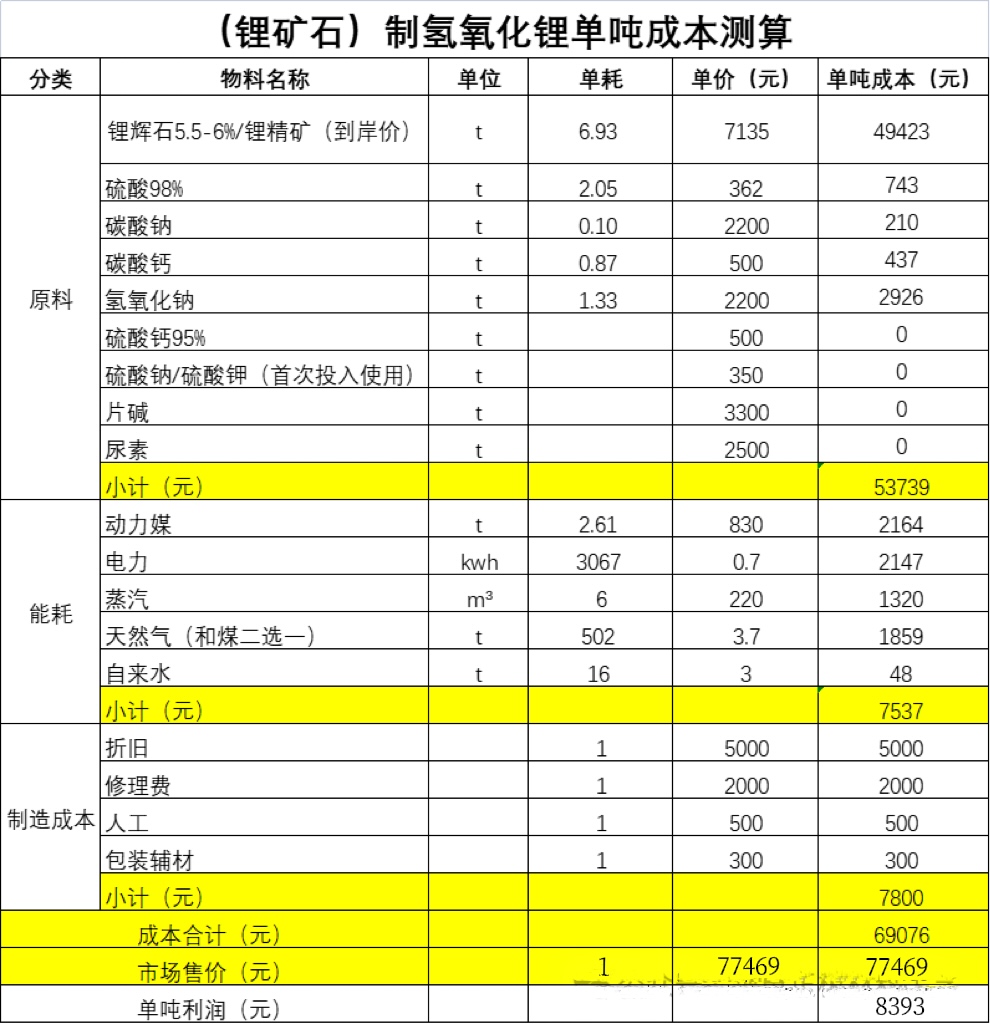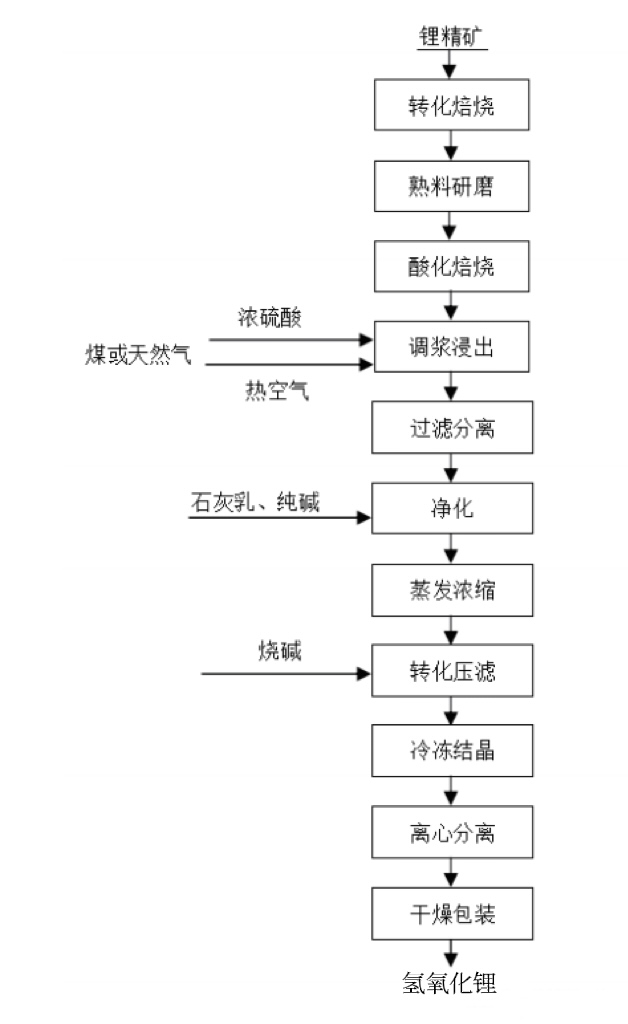Analysis of Domestic Lithium Hydroxide Production Process and Single Ton Cost
Aug,08,24
Lithium products play a very important role in modern industry,
with wide applications in new energy and new materials fields such as battery industry, aluminum industry,
lubricating grease, medicine, refrigerant, nuclear industry, and optoelectronic industry.
With the advancement of technology, the application scope of lithium products continues to expand, and demand continues to grow rapidly.
The industry has a very broad development prospect.
The sustained growth of the new energy vehicle market has driven the growth of the power battery industry.
Given the persistent pursuit of high endurance mileage and vehicle lightweighting on the demand side,
the trend towards high nickel content remains steadfast in the long term.
Under the trend of high nickel in power batteries, the demand for lithium salts is gradually shifting from lithium carbonate to lithium hydroxide,
and lithium hydroxide replacing lithium carbonate may become a trend.
High energy density high nickel ternary materials must use lithium hydroxide.
With the continuous acceleration of the development speed of high nickel ternary cathode materials
and the large-scale application of high nickel ternary materials in power batteries,
the demand for lithium hydroxide will continue to increase,
and the lithium hydroxide and its preparation industry will receive widespread attention from the industry.
Cost analysis of lithium hydroxide production
The main raw and auxiliary materials used in the production process of lithium hydroxide are spodumene concentrate,
sulfuric acid, soda ash, caustic soda, calcium carbonate, etc;
There are two main aspects of energy consumption in the production process of products:
one is the electricity consumption during equipment operation;
The second is the heat consumption during the production process.
This article calculates the direct cost of major lithium hydroxide enterprises in China based on their raw
and auxiliary material consumption, energy consumption, and lithium recovery rate.
The cost calculation is shown in the table and figure below.
From the above table, it can be seen that the cost of raw materials accounts for about 80% of the direct cost of lithium hydroxide,
indicating the importance of upstream lithium resources in cost control for enterprises.
Cost control is one of the core aspects of comprehensive competition in lithium chemical enterprises,
and it is also a performance indicator that reflects the internal management mechanism and operational effectiveness of the enterprise.
Enterprises can control costs by investing in lithium resources and obtaining stable and high-quality lithium raw materials;
It is also possible to improve product quality and reduce unit product costs through continuous improvement
and innovation of various production processes, equipment, and technologies;
It is also possible to increase R&D investment for technology project research and industrialization of scientific research results,
increase the premium ability of high-end products through product differentiation strategy,
ensure cost-effectiveness, and improve overall profitability.

Current Status of Lithium Hydroxide Production
In 2019, lithium hydroxide became the main growth driver for lithium compounds due to the rapid development of high nickel ternary batteries.
According to a research report by Minmetals Securities, the global production
and sales volume of lithium hydroxide monohydrate in 2019 was approximately 99600 tons,
with a demand of approximately 79700 tons, of which the demand in the lithium-ion battery field was approximately 62000 tons.
It is expected that the total global demand for lithium hydroxide will increase significantly to 566000 tons by 2025,
with a compound annual growth rate of about 38.65% from 2019 to 2025.
In 2022, the demand for lithium hydroxide in lithium batteries is expected to surpass that of lithium carbonate.
Currently, the global production capacity of high-quality lithium hydroxide is concentrated in China.
With the acceleration of Tesla's localization and the efforts of high nickel models such as BMW and NIO,
the demand and production of battery grade lithium hydroxide in China will increase significantly in 2020.
Currently, the raw material source of lithium hydroxide in China is more singular compared to lithium carbonate,
mainly using spodumene concentrate as raw material, with a higher concentration of manufacturers.
Production process of lithium hydroxide
The process path for producing lithium hydroxide from ores and salt lakes is mature,
but in actual production, producing high-quality lithium hydroxide products is not simple,
especially with high process barriers for impurity removal.
Downstream customers usually have differentiated indicator requirements,
which also makes it difficult for lithium hydroxide, especially battery grade lithium hydroxide, to become a standardized commodity.
Ore can be used to produce battery grade lithium hydroxide in one step.
Firstly, lithium concentrate is roasted and acidified to produce lithium sulfate solution.
Then, lithium sulfate is converted by sodium hydroxide and processed through filtration,
evaporation concentration, crystallization (some using multiple crystallization), drying,
and other processes to produce battery grade lithium hydroxide;
The mature process of salt lake is to first produce lithium carbonate,
and then produce lithium hydroxide through causticization.
Although salt lake lithium extraction has abundant resources, due to the high impurity content and technical universality of salt lake lithium extraction,
as well as the tendency of salt lake lithium extraction enterprises to directly sell high-quality lithium carbonate products,
industrial grade (or sub optimal) lithium carbonate is used as raw material for the production of back-end lithium hydroxide,
which will lead to difficulties in ensuring the quality and consistency of their lithium hydroxide products;
Salt lake lithium extraction enterprises are also actively experimenting with the process of brine electrolysis to produce lithium hydroxide,
but in mass production, the maturity of the process and product quality still need to be observed and verified.
The commonly used production methods for lithium hydroxide from ore extraction include lithium carbonate and calcium hydroxide method,
calcination method, lithium sulfate method, etc.
The production process of lithium carbonate and calcium hydroxide can obtain a solution with a concentration of about 3.5%.
If the concentration is higher than this, due to the presence of lithium hydroxide,
the solubility of lithium carbonate decreases and it remains in the calcium carbonate residue, causing losses.
The disadvantage of calcination method is that the use of magnesium makes the process flow complex,
equipment corrosion is severe, evaporation water volume is large, and energy consumption is high.
The lithium sulfate method for producing lithium hydroxide has a high recovery rate,
can be continuously produced, and can achieve automated control.
The product performance is stable and the production cost is low. It is currently the main production method in China.
The lithium sulfate process uses natural lithium concentrate (alpha type) as raw material.
Firstly, the alpha lithium concentrate is converted into beta lithium concentrate that is easily reacted with sulfuric acid through rotary kiln roasting.
Then, the lithium element in the lithium concentrate is extracted by sulfuric acid method.
Water is added for pulping and leaching to make solid lithium sulfate liquid.
Lime powder and calcium carbonate are added to adjust the pH value. Impurities such as iron, calcium, and magnesium are filtered out.
After further removing calcium by adding sodium carbonate and ion exchange,
the lithium sulfate leaching solution is appropriately evaporated and concentrated.
After adding sodium hydroxide, sodium sulfate decahydrate is separated by cooling to -5 ℃~-15 ℃.
The separated mother liquid is evaporated and concentrated to crystallize crude lithium hydroxide monohydrate.
Finally, it is recrystallized. Obtain high-quality lithium hydroxide monohydrate.
The basic principle is mainly to use the different solubility of Na2SO4 and LiOH at low temperatures,
and to separate Na2SO4 at low temperatures to achieve the purpose of purifying liquids.
The main reaction equation is as follows:
α-Li2OAl2O34SiO2→ β-Li2OAl2O34SiO2
Li2OAl2O34SiO2+H2SO4→ Li2SO4+H2OAl2O34SiO2
Li2SO4+2NaOH+10H2O→ 2LiOH+Na2SO410H2O
Production process of lithium hydroxide

This article introduces the mainstream processes and cost analysis of lithium hydroxide production based
on the production situation of lithium hydroxide.
With the continuous improvement of market requirements for the endurance and driving range of new energy vehicles,
the demand for energy density of power batteries is also increasing.
Taking the high nickel ternary route has gradually become a common choice for mainstream car companies.
The growth of demand for high nickel ternary materials will directly drive the growth of demand for lithium hydroxide.
Enterprises must continue to adhere to cost reduction and efficiency improvement, continuously reduce product costs, and improve product quality.
Specifically, they must carry out international strategic layout in resources, capital, personnel, production lines, sales and technology, investment, etc.,
while adhering to being close to the market and guiding the sustainable, healthy and stable development of the market;
Adhere to the high-end and differentiated product orientation, continuously optimize production processes, and strive to improve product quality;
Adhere to the focus on cutting-edge industry technology directions, continuously tap into the potential of existing production line capacity,
accelerate independent research and development and reserve of new technologies, equipment,
and processes, achieve the transformation from simple lithium processing and manufacturing business to integrating lithium resource reserve, development, trade,
and lithium series product processing, extend the industrial chain upstream and downstream,
climb the value chain to the high-end, and further enhance core competitiveness.






